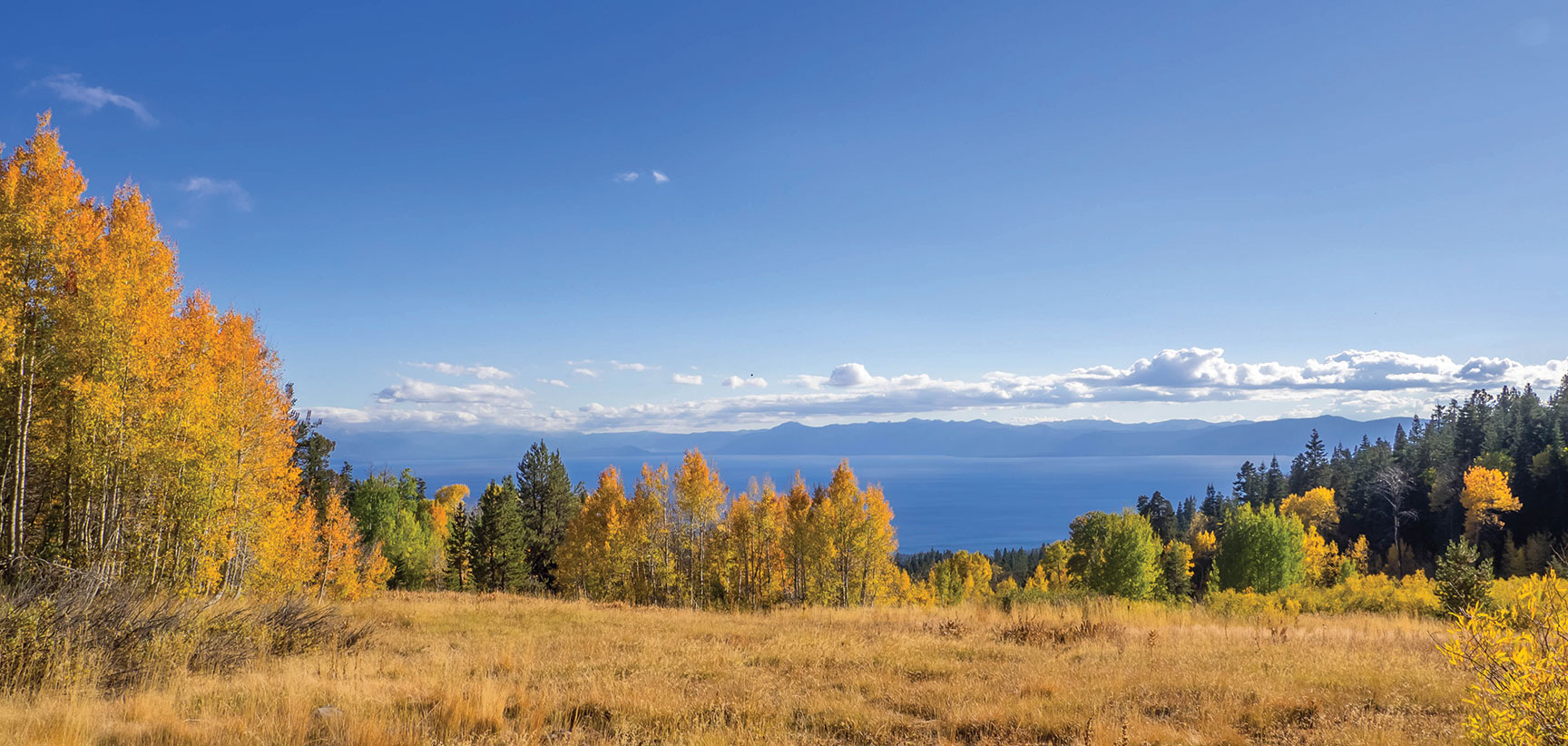
24 Sep Capturing Autumn’s Art
The Tahoe Basin may not compare to the East Coast when it comes to colorful fall foliage, but the region offers ample opportunities nonetheless for photographers of all abilities
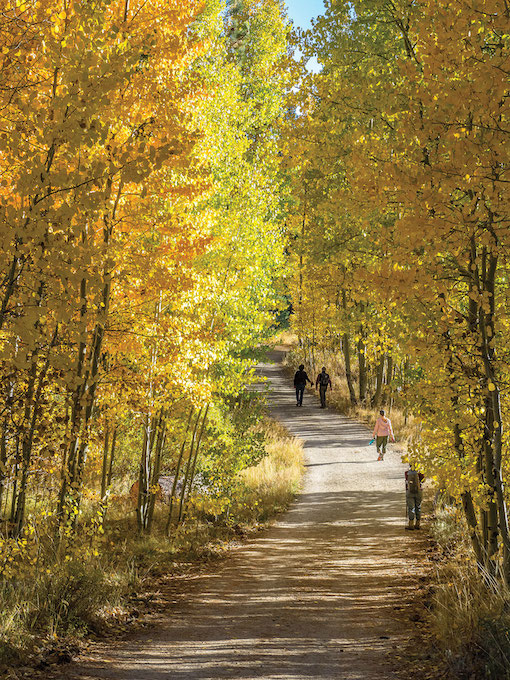
Hikers enjoy an aspen stand near Spooner Lake
Maine. Vermont. The Great Smoky Mountains. These are the places that come to mind when people think about fall foliage at its best. California and Nevada? Not so much.
But the truth is, we have some great fall color in the Tahoe Basin and surrounding areas. While we don’t have the same range of hues as the East Coast, the contrast between the brilliant gold leaves of our deciduous trees, the clear blue sky and the dark green of the conifers makes for wonderful photographic opportunities.
The following guide is intended to help photographers—whether novice or pro, local or visitor—find the best fall shooting locations in the Tahoe area.
Finding Fall Colors
The peak time to catch fall colors varies from year to year, depending on rainfall and temperature. Elevation also plays a role.
Deciduous trees such as aspen, cottonwood and willow—the main staples in the Tahoe Basin—begin their autumn transformation earlier at the higher end of their ranges. As such, if you are looking at trees that have already shed their leaves, simply drive farther down the mountain. Conversely, if trees have yet to turn color, head uphill.
In general, colors will start popping in late September and continue through October, with aspen leaves turning shades of yellow, gold, orange and even red.
Keep in mind that the mountains can get snow in the fall. Not to worry. It will be melted off the roads by the residual heat in a short time and will simply add a new dimension to your fall photos. A babbling brook with snow on the rocks and golden aspen leaves reflected in the water is a delightful thing to come across.
Fallen Leaf Lake
Most people associate Kokanee salmon with October photo opportunities at Lake Tahoe—and for good reason. It is a great outing. But if you continue a little farther up the road in the direction of Emerald Bay, you will come across fantastic aspen groves along the highway that will call you to stop and make some images that will impress your friends on social media.
If you turn west on Fallen Leaf Lake Road, things get even better. My favorite section is a short distance past the campground. A wide meadow features a trail that travels north to the lake through huge stands of aspens. The hike is short and flat, making it a good option for those who are not acclimatized.
The sun drops behind the mountain early here, so if you want to capture the sunlight coming through the aspen leaves, arrive mid-afternoon or perhaps think about a morning visit. If the morning is frosty, look to capture frost on the tall grass in the meadow with the aspen trees contrasting against the blue sky.
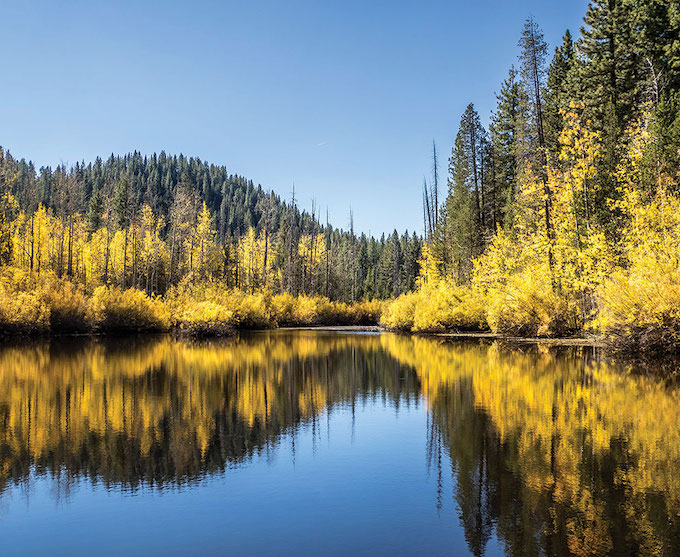
Bliss Pond between Incline Village and Spooner Lake is lined with aspens and willows
Bliss Pond
Driving along Highway 28 between Spooner Lake and Incline Village in the fall, motorists can’t help but notice the golden aspens surrounding a small pond. This is Bliss Pond, which was created during the logging era.
The pond is small enough to provide marvelous reflections of the fall colors. That is the good news. The bad news is that it is difficult to photograph.
The determined photographer will have better luck hiking around the north side of the pond, as the south side gets quite marshy.
Marlette Lake
For the photographer who enjoys hiking and mountain biking, Marlette Lake is the place to go. Simply head up the North Canyon trail from Spooner Lake until reaching the remarkable view of Marlette Lake.
The best aspen groves are on the east shore. Ask around before going to see how the leaves are looking. The rangers will be expecting you, and they will write some advice on a board at the entrance station.
Spooner Lake
The aspens on the east shore of Spooner Lake have been damaged by the caterpillars of the white satin moth. This is tragic because the reflection of those trees in the lake on a still day made for wonderful photographs. There are still some great images to be captured here, but not like there used to be.
One good option that remains in this area is the North Canyon trail just before Spencer’s Cabin, which passes through aspen groves on both sides. Past the historic cabin, the trees are less concentrated but still beautiful.
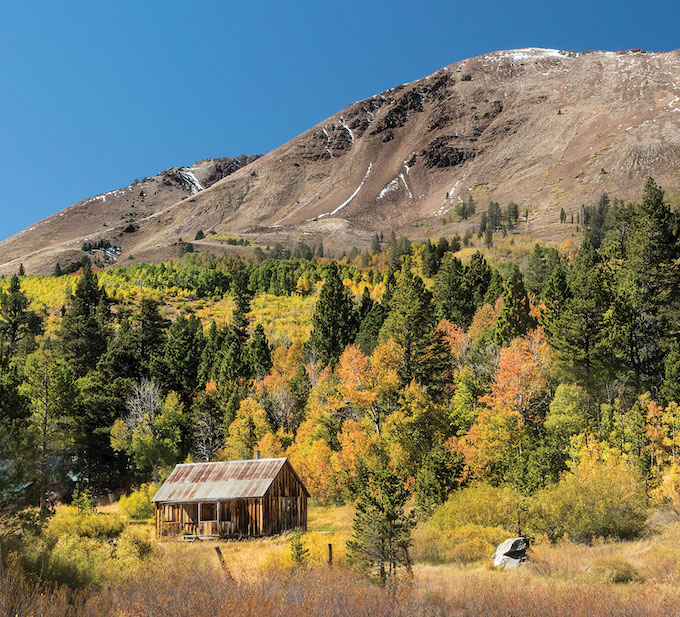
Hope Valley is among the better locations in the Tahoe area to photograph fall colors
Hope Valley
South of Lake Tahoe is a beautiful area called Hope Valley. Aside from Sorensen’s Resort—a glorious place to stop and have lunch or book a cabin—the prime destination at Hope Valley is the cabin on the way to Carson Pass. The cabin is on the north side of the highway near a big pullout that offers safe parking, which is good because it is very popular.
The downside of the Hope Valley cabin is that it offers few perspectives. I shoot with a telephoto lens for close-ups, then take some wide-angle shots that include the whole mountain behind the cabin. Then I go photograph elsewhere in Hope Valley and return later in the day when the light has changed and shoot it again.
Incline Flume
The Incline Flume juts off from the Mount Rose Highway a couple hundred yards above the Lake Tahoe scenic overlook. Head southeast along the trail to discover aspen trees that climb up through the canyons, like a river of gold.
Martis Cabin
The old ranger cabin on the north side of Brockway Summit loses a few more boards every year, but it is still standing. To find it, head north from Kings Beach along Highway 267. You will see it along the west side of the road, nestled in a large aspen grove and likely surrounded by photographers.
A wide pullout will give you a safe place to park. The sun ducks behind the hill early at this location, so plan accordingly. My favorite time to visit this cabin is mid-morning when the sun is striking it directly.
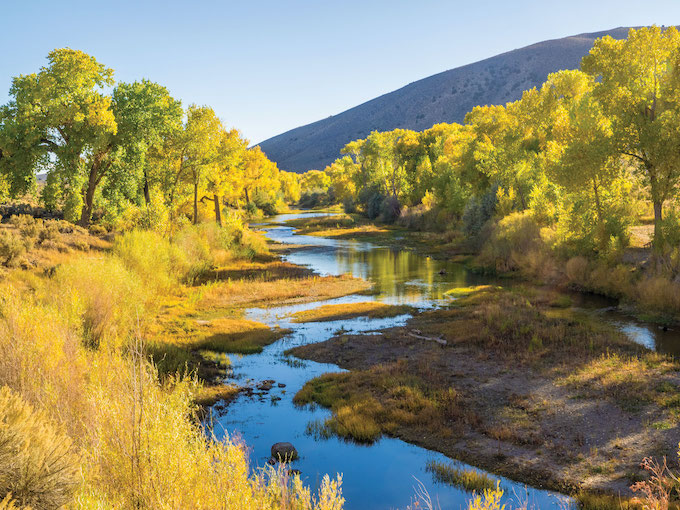
Cottonwoods put on a colorful show along the Carson River
Carson River
A short distance east of Lake Tahoe is the beautiful Carson River, which features cottonwood trees instead of aspens. Head down this way later in October or even in early November for the best color. If you have time, drive up Six Mile Canyon toward Virginia City, or to Fort Churchill farther downstream.
Tips and Techniques
In order to get the best images of Tahoe’s fall colors, think about the light angles. The sun is lower in the sky in October, so you may find that it will be behind a ridge until mid-morning and will sync behind another in mid-afternoon. If you are lucky enough to catch the sun just as it rises or sinks behind the ridge, stop down your lens to f/16 or so to capture a sunburst coming through the trees. If there is no handy ridge, then use the branches and leaves themselves to create that sunburst.
Remember, too, that aspen leaves will flutter in the lightest wind, so watch your shutter speeds. Shooting at Marlette Lake, I sometimes use a neutral density filter for exposures of several seconds to smooth out the ripples on the water. This means that the leaves are also in motion, but they are far enough away that I don’t consider this to be a negative.
Part of the fun in photographing fall colors is the thrill of the find. So when the temperature begins to dip, don’t be afraid to get out with your camera and explore. You might just discover a secret treasure trove of fall colors waiting to be photographed.
Martin Gollery is a photographer and writer who has lived at Lake Tahoe for over 20 years. Find more of his work at TahoePhotography.net.




No Comments